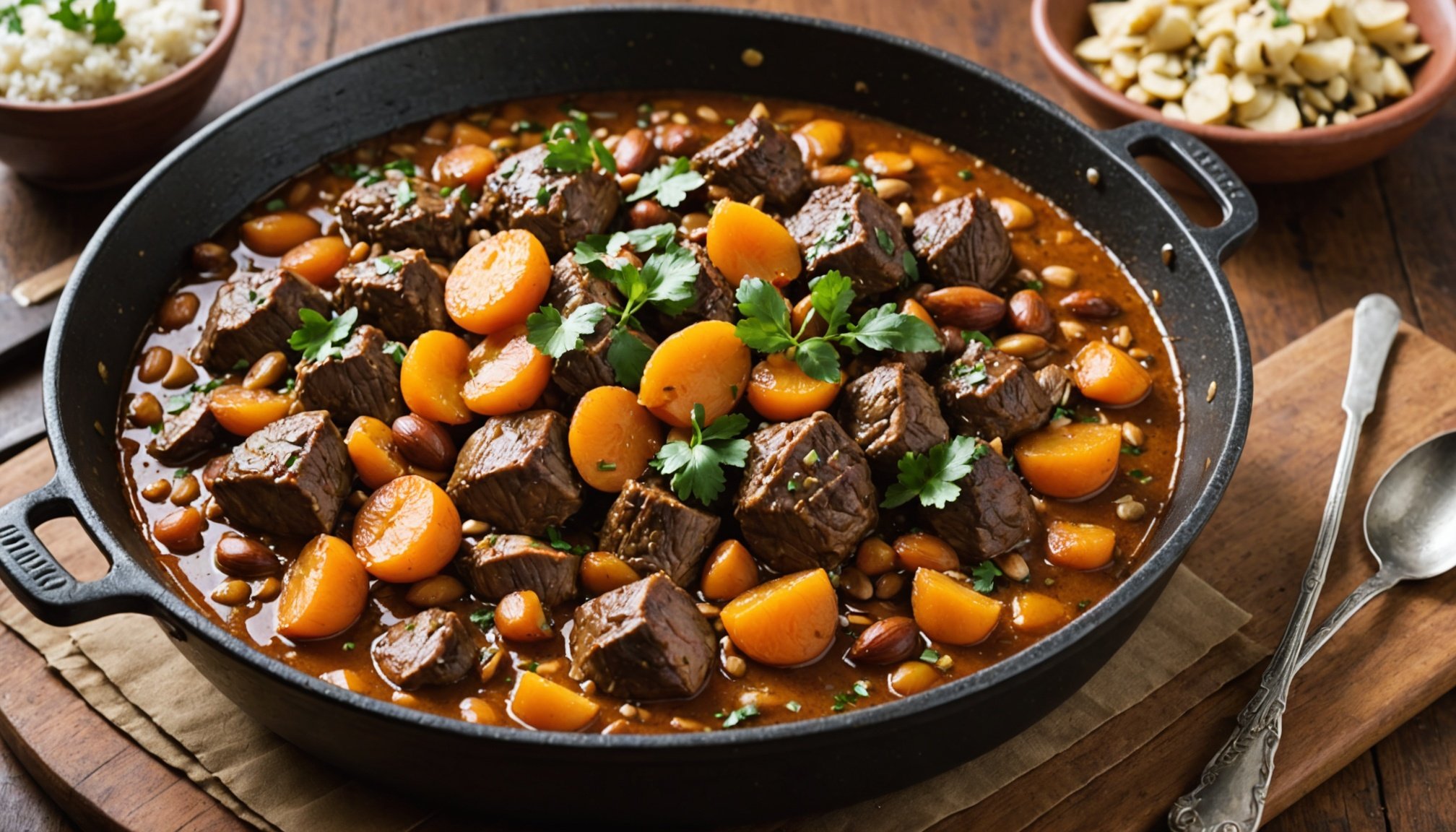Recipe Overview
Moroccan lamb stew is a delightful dish renowned for its intricate flavours and cultural significance within North African cuisine. This delectable stew features succulent lamb, sweet apricots, and crunchy almonds, creating a balance between savoury and sweet that is both unique and captivating. Each ingredient plays a crucial role in imparting the distinct taste that is emblematic of Moroccan culinary tradition.
The lamb serves as the hearty base, infusing its richness throughout the dish. Apricots add a layer of sweetness which mellows the savoury flavours, while almonds provide a delightful crunch, enhancing the texture of the stew. This juxtaposition of flavours and textures is what makes Moroccan lamb stew a truly exceptional recipe.
Also to discover : Savor the elegance: create an irresistible french onion tart with gruyère cheese!
Preparing this stew is a rewarding journey, though it requires patience. The cooking time is approximately two hours, allowing the flavours to meld together beautifully. This dish serves well at family gatherings, festive occasions, or any event where you wish to impress. Pairing it with couscous or warm flatbread is highly recommended, storing the taste and spirit of Morocco in every bite. Embrace this culinary adventure and invite an exotic taste to your table with Moroccan lamb stew.
Ingredient List
For an authentic Moroccan lamb stew, selecting the right ingredients is crucial. The main ingredients for Moroccan lamb stew that define its rich and savory taste include lamb, apricots, and almonds. These not only contribute unique flavors but also add texture and depth to the dish.
Additional reading : Elevate your burger game: indulge in a gourmet bison burger with irresistible blueberry bbq sauce!
Main Ingredients
- Lamb: Choose high-quality cuts like shoulder or leg for the best results. Lamb is the heart of the stew and its quality crucially affects the flavor.
- Apricots: Dried apricots introduce natural sweetness that complements the savoury elements. They should be plump and not overly dry.
- Almonds: Typically toasted, almonds provide a subtle nutty flavor and a satisfying crunch.
Optional Ingredients
To add variety or personalize your stew, consider these optional ingredients:
- Chickpeas for additional fibre.
- Preserved lemons for tanginess.
- Ras el hanout for a spice blend twist.
Depending on regional preferences within Moroccan cuisine, you might find variations using ingredients like prunes or raisins instead of apricots.
Spice Profile
Spices breathe life into Moroccan lamb stew, with each playing a role in crafting its unmistakable aroma and taste. Common spices include cumin, coriander, cinnamon, ginger, and paprika. These enhance the overall flavor by adding warmth, depth, and complexity, inviting one to experience the vibrant essence of Moroccan culinary art.
Preparation Steps
Creating a delicious Moroccan lamb stew is an art that begins well before the pot hits the stove. Detailed preparation methods ensure a rich and flavourful outcome. Start by gathering all the necessary ingredients to avoid any mid-cooking surprises. This includes spices, vegetables, and herbs alongside your lamb.
A crucial part of the preparation is the marinade. Allow the lamb to soak in an aromatic mixture of spices and herbs—preferably overnight—to ensure full flavor infusion. This resting time is not just about tenderness; it’s the key to a stew that bursts with taste in every bite.
Organising your workspace beforehand enhances efficiency. Arrange all ingredients and tools within arm’s reach, which minimizes cooking disruptions. Next, focus on efficient ingredient preparation. Chop vegetables uniformly for even cooking and prepare spice blends in advance.
Utilizing cooking techniques such as searing the lamb before slow cooking seals in the juices and adds depth to the stew’s flavor. Consistently stirring during simmering helps distribute flavors evenly.
By following these steps, the path to a remarkable Moroccan lamb stew becomes effortless and enjoyable. Preparation forms the foundation of cooking, transforming everyday ingredients into a hearty dish with complex flavors.
Cooking the Stew
Navigating between the stovetop method and the slow cooker method can transform the way you prepare a Moroccan lamb stew. Each technique offers unique benefits which can suit various lifestyles and preferences.
Stovetop Cooking Method
For the stovetop method, begin by heating oil in a large pot over medium heat. Achieving the right temperature is crucial. Brown the lamb pieces thoroughly on all sides, which helps to lock in flavour. Lower the heat to a simmer once you’ve added the remaining ingredients, such as vegetables and spices. Cooking instructions typically suggest simmering the stew for approximately two hours, stirring occasionally. You’ll know it’s ready when the lamb is tender and the stew exhibits a rich consistency.
Slow Cooker Adaptation
Adjustments for your slow cooker are straightforward. Start by browning the lamb on the stovetop before transferring it to the slow cooker. This technique enhances flavour. Cook the stew on low heat for 6 to 8 hours or on high for 3 to 4 hours. The meat should fall apart easily when done, ensuring a succulent texture.
Flavor Building Techniques
Building depth of flavour in a Moroccan lamb stew involves layering spices; start with aromatic spices such as cumin and coriander early in cooking. Consider adding fresh herbs and citrus zest towards the end to balance and brighten the dish.
Flavor Pairing and Serving Suggestions
Successfully serving Moroccan lamb stew involves understanding its rich and complex flavours. For an enhancing experience, consider serving it with traditional accompaniments like couscous or fragrant basmati rice. These options not only soak up the stew’s robust sauce but also complement the succulent lamb.
For a refreshing contrast, include a side of tangy yogurt dip or a vibrant cucumber salad. These additions cut through the stew’s richness and bring a refreshing balance. Toasted bread or naan can also be served to mop up the flavourful broth, adding a satisfying texture to the meal.
When it comes to beverage pairings, a full-bodied red wine, like a Syrah, or a Moroccan mint tea can elevate the dining experience. For those preferring non-alcoholic options, mint-infused lemonade provides a zesty counterpoint to the stew’s hearty flavors.
In terms of presentation, consider serving the stew in a traditional tagine dish. This not only maintains the stew’s warmth but also echoes its origins, adding an authentic touch. Garnish with fresh herbs or a sprinkle of sesame seeds to boost visual appeal and add an extra layer of flavour.
Savvy pairing and thoughtful presentation will make this dish the star of any meal.
Tips and Variations
Exploring the diversity and adaptability of Moroccan stews is both intriguing and rewarding. Each variation offers unique takes on this traditional dish, often influenced by regional and seasonal availability.
Popular Variations
Moroccan stew variations are abundant, reflecting the diverse tastes across Morocco. Coastal areas might incorporate seafood, while inland regions might lean towards lamb. Seasonal ingredients, like squash in autumn, add a fresh twist to the classic flavors. This adaptability allows each region to create its unique signature on the stew, making each experience unique.
Cooking Tips
Cooking tips are essential for optimizing both flavor and texture in these stews. To enhance taste, consider layering spices and allowing the stew to simmer slowly. This facilitates the melding of flavors and tenderizes meat or vegetables. However, a common mistake is rushing the cooking process, which can lead to uneven flavors and textures. Allow time for the ingredients to harmonize for best results.
Ingredient Substitutions
Ingredient substitutions are helpful for accommodating dietary restrictions without compromising taste. Chickpeas can replace meat for a vegetarian version, while quinoa can substitute for couscous as a gluten-free alternative. When making substitutions, it’s crucial to balance flavors using suitable spices or herbs to maintain the stew’s authentic taste.
Background on Moroccan Cuisine
Moroccan culinary traditions are a rich tapestry woven through centuries of history and influences. The cuisine reflects a unique blend of Berber, Arab, and French influences, creating a vibrant tapestry of flavours and methods. These diverse influences have helped shape the rich and complex flavor profiles that are synonymous with Moroccan dishes, providing a sensory experience that is as culturally significant as it is delectable.
In Morocco, the cultural significance of communal dining cannot be understated. Sharing meals is deeply rooted in Moroccan social customs, symbolising warmth, generosity, and community. Meals are often enjoyed over extended periods, allowing family and friends to gather, converse, and strengthen bonds. This practice highlights the importance of both the meal and the company present, ensuring that the dining experience extends beyond mere sustenance.
At the heart of Moroccan cuisine are the unique flavor profiles and cooking methods that contribute to its distinct character. Key spices such as cumin, coriander, and saffron blend seamlessly with ingredients like preserved lemons, olives, and dried fruits. These flavours are accentuated through creative cooking methods including stewing, slow-cooking in tagines, and grilling over open flame. Together, these techniques and ingredients create a culinary tradition as rich and inviting as Morocco itself.











